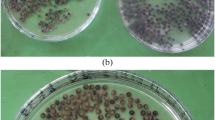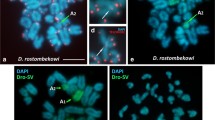Abstract
A diploid member of the parthenogenetic gekkonid species complexHemidactylus garnotii-vietnamensis was discovered for the first time from Thailand. This gecko, seemingly unisexual and parthenogenetic, possesses 2n=2x=38 chromosomes, showing distinct heteromorphisms. The absence of bisexual congeneric species with a combination of karyomorphs to produce this karyotype indicates the occurrence of chromosomal rearrangements after the initial estabilishment of a diploid clonal lineage of hybrid origin. Results of karyotypic comparisons of the present sample and the three known triploid species belonging to theH. garnotii-vietnamensis complex suggest that a triploid karyomorph similar to that ofH. vietnamensis has first emerged through an insemination of the diploid parthenogen's egg by the sperm from a bisexual species having 44 chromosomes (all telocentric), and that the karyomorph subsequently experienced some minor chromosomal aberrations to produce the karyomorphs ofH. vietnamensis andH. garnotii. The origin of theH. stejnegeri karyotype still remains an open question for future studies.
Similar content being viewed by others
References
Cole, C.J., 1979. Chromosome inheritance in parthenogenetic lizards and evolution of allopolyploidy in reptiles. J. Hered. 70: 95–102.
Cole, C.J., H.C. Dessauer & G.F. Barrowelough, 1988. Hybrid origin of a unisexual species of whiptailed lizard,Cnemidophorus neomexicanus, in western North America: new evidence and a review. Am. Mus. Novitates 2905: 1–38.
Darevsky, I.S., 1992. Evolution and ecology of parthenogenesis in reptiles, pp. 21–39 in Herpetology, edited by K. Adler. Society for the Study of Amphibians and Reptiles, Oxford, Ohio.
Darevsky, I.S., L.A. Kupriyanova & V.V. Roshchin, 1984. A new all-female triploid species of gecko and karyological data on the bisexualHemidactylus frenatus from Vietnam. J. Herpetol. 18: 277–284.
Darevsky, I.S., L.A. Kupriyanova & T. Uzzell, 1985. Parthenogenesis in reptiles, pp. 412–526 in Biology of the Reptilia, Vol. 15B, edited by C. Gans and F. Billet. Wiley Interscience, New York, NY.
Dawley, R.M. & J.P. Bogard (eds.), 1989. Evolution and Ecology of Unisexual Vertebrates. New York State Museum, Albany, NY.
Green, D.M. & S.K. Sessions, 1991. Nomenclature for chromosomes, pp. 431–432 in Amphibian Cytogeneties and Evolution, edited by D.M. Green and S.K. Sessions. Academic Press, San Diego, California.
Kluge, A.G. & M.J. Eckardt, 1969.Hemidactylus garnotii Duméril and Bibron, a triploid all-female species of gekkonid lizard. Copeia 1969: 651–664.
Moritz, C., 1987. Parthenogenesis in the tropical gekkonid lizard,Nactus arnouxii (Sauria: Gekkonidae). Evolution 41: 1252–1266.
Mortiz, C., 1991. The origin and evolution of parthenogenesis inHeteronotia binoci (Gekkonidae): evidence for recent and localized origins of widespread clones. Genetics 129: 211–219.
Moritz, C., T.J. Case, D.T. Bolger & S. Donnellan, 1993. Genetic diversity and the history of Pacific island house geckos (Hemidactylus andLepidodactylus). Biol. J. Linnean Soc. 48: 113–133.
Ota, H. & T. Hikida, 1989a. A new triploidHemidactylus (Gekkonidae: Sauria) from Taiwan, with comments on morphological and karyological variation in theH. garnotii-vietnamensis complex. J. Herpetol. 23: 50–60.
Ota, H. & T. Hikida, 1989b. A record of a triploid gecko,Hemidactylus stejnegeri, from the northern Philippines. Japan. J. Herpetol. 13: 35–39.
Ota, H., T. Hikida & K.-Y. Lue, 1989. Polyclony in a triploid gecko,Hemidactylus stejnegeri, from Taiwan, with notes on its bearing on the chromosomal diversity of theH. garnotii-vietnamensis complex (Sauria: Gekkonidae). Genetica 79: 183–189.
Ota, H., T. Hikida, M. Matsui & A. Mori, 1992. Karyotypes of two species of the genusCyrtodactylus (Squamata: Gekkonidae) from Sarawak, Malaysia. Caryologia 45: 43–49.
Ota, H., I.S. Darevsky, L.A. Kupriyanova, T. Hikida, K.-Y. Lue, S.-H. Chen & T. Hayashi, 1993. Geographic variation in the parthenogenetic lizard,Hemidactylus stejnegeri (Gekkonidae Reptilia), with comments on recently discovered male pheno-types. Trop. Zool. 6: 125–142.
Ota, H., M.W. Lau & A. Bogadek, 1995. Taxonomic status of the Hong Kong populations of theHemidactylus garnotii-vietnamensis complex (Gekkonidae: Reptilia). Zool. Stud 34: 126–130.
Radtkey, R.R., S.C. Donnellan, R.N. Fisher, C. Moritz, K.A. Hanley & T.J. Case, 1995. When species collide: the origin and spread of an asexual species of gecko. Proc. R. Soc. Lond. B 259: 145–152.
Schmid, M., W. Feichtinger, I. Nanda, R. Schakowski, R. Visbal Garcia, J. Manzanilla Puppo & A. Fernandez Badillo, 1994. An extraordinarily low diploid chromosome number in the reptileGonatodes taniae (Squamata, Gekkonidae). J. Hered. 85: 255–260.
Smith, M.A., 1935. The Fauna of British India Including Ceylon and Burma. Reptilia and Amphibia, II-Sauria. Taylor & Francis, London.
Taylor, E.H., 1963. The lizards of Thailand. Univ. Kansas Sci. Bull. 44: 687–1077.
Volobouev, V., G. Pasteur, I. Ineich & B. Dutrillaux, 1993. Chromosomal evidence for a hybrid origin of diploid parthenogenetic females from the unisexual-bisexualLepidodactylus lugubris complex (Reptilia, Gekkonidae). Cytogenet. Cell Genet. 63: 194–199.
Werner, Y.L., 1956. Chromosome numbers of some male geckos (Reptilia: Gekkonoidea). Bull. Res. Counc. Israel 5B: 319.
Author information
Authors and Affiliations
Rights and permissions
About this article
Cite this article
Ota, H., Hikida, T., Matsui, M. et al. Discovery of a diploid population of theHemidactylus garnotii-vietnamensis complex (Reptilia: Gekkonidae). Genetica 97, 81–85 (1996). https://doi.org/10.1007/BF00132584
Received:
Accepted:
Issue Date:
DOI: https://doi.org/10.1007/BF00132584




